An Old Shipyard Next to Ming Wah: A Witness to the Transformation of Shau Kei Wan
An Old Shipyard Next to Ming Wah:
A Witness to the Transformation of Shau Kei Wan
Wong Kwai Chuen
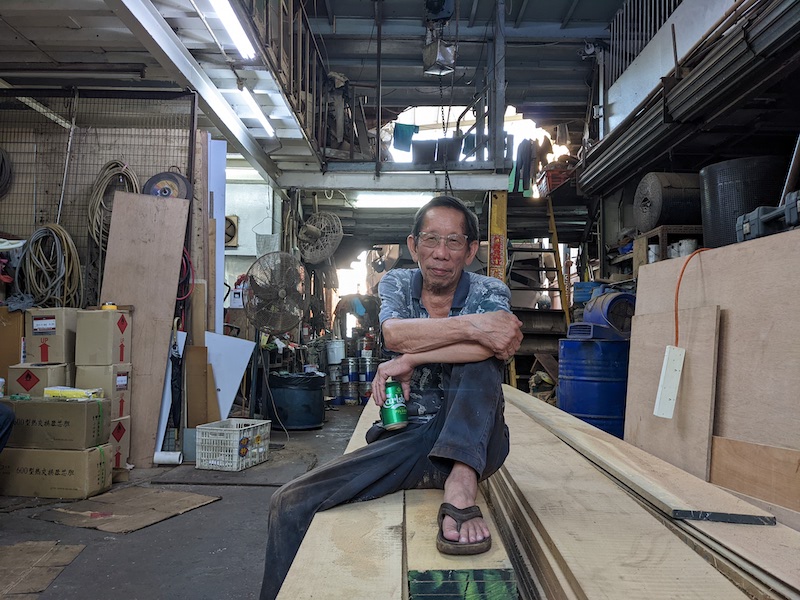
As a young man, Chuen Gor enjoyed living in the shipyard, where there was enough space to accommodate friends from the stilt huts that he invited over to eat and watch TV, even though his family had already owned a flat at that time.
Shau Kei Wan, where Ming Wah Dai Ha stands, was a fishing bay in the 1950s. The coastline was quite different then, and the sea used to be located where the current bus terminus is situated. Fishing boats would dock near Main Street East to sell their catch. Pui Kee Shipyard has been around in Shau Kei Wan for over seven decades, having moved twice as a result of the changing coastline. It was initially sitting near Nam On Lane before being relocated to its current location next to Tam Kung Temple. The shipyard has borne witness to the growth and transformation of over the past half-century. Wong Kwai Chuen, also known as Chuen Gor, grew up in Pui Kee and took over the shipyard from his father. He recalled Ming Wah Dai Ha’s significant role in the lives of Shau Kei Wan’s residents, particularly children who would run around everywhere. “We always wanted to play on their ping pong tables,” he reminisced.
70 years of history - Witnessing Shau Kei Wan’s transformation
Chuen Gor, like Pui Kee Shipyard, is in his 70’s. He spent much of his time in Shau Kei Wan by the sea, getting a nice tan from the sun. After work, he enjoys unwinding with a beer. Taking a sip, he recalls his childhood memories of Shau Kei Wan, many of which are linked to Ming Wah Dai Ha.
Founded by Chuen Gor’s father, Pui Kee Shipyard was initially located near Nam On Lane in the 1950s, when Aldrich Garden and Oi Tung Estate were still part of the sea. Back then, the fishing industry was thriving in the area, and most of the people who hung out around Main Street East and Sai Wan Ho Depot were living on the sea. Taikoo Dockyard was also close by, where ships were built and repaired. Chuen Gor started working at the shipyard when he was just over 10 years old. He fondly remembers a time when a fisherman came to place an order: “I want a 46ft boat for grouper fishing,” the customer said. Without hesitation, the builder replied, “Sure, what material do you want? Teak, fir, shorea…” Chuen Gor recalls that building a ship back then started with finding a piece of wood, before carving, burning and hammering it into shape. “We wouldn’t give them scrap wood.”
Fishermen used to get their supplies from Main Street East, which is now lined with restaurants. The shops along the street sold everything they needed for fishing trips, including fuel, kerosene lamps, fresh water and fishing nets. They were very particular about their nets. “Before the invention of nylon ropes, we had to soak the hemp rope nets in salted egg white to make them last longer. That’s why there were so many salted egg yolks for sale in the fishing village.”
For Chuen Gor, Shau Kei Wan was not only a place of work, but also his home. When he was younger, he worked at the shipyard during the day and slept there at night. He never hesitated to volunteer as a firefighter when there was a fire on the hillside. Chuen Gor vividly remembers one year, 1976, when a fire broke out in the squatter area near Aldrich Bay, where most of the fishermen lived. It was the second day of the Lunar New Year, and everyone was enjoying their family reunion. Even though the fire was far away from the shipyard, he told his mother, “Grab your stuff, and whatever valuables you could carry.” Then, he rushed to help put out the fire. He and his neighbours worked non-stop, holding onto the water hoses from afternoon until the next morning. “Then we went for dim sum,” he said.
Ming Wah: Where kids’ playtime meets mom’s respite
“I often went to Ming Wah Dai Ha where I knew a lot of residents there.” He remembers Ming Wah Dai Ha as a warm and friendly community. “People got along well with their neighbours, everyone was trusting of everyone else. There was one long corridor, everyone opened their doors, and people chatted and laughed with each other, helping out whenever they could.” He also remembered that many blocks in Ming Wah had ping pong tables on the ground floor, which attracted kids from the neighbourhood. “We kids loved Ming Wah’s ping pong tables,” he said. There was also a hillside near A Kung Ngam Road with flowing water, where many neighbours washed their cars, played chess or cooled themselves off. Despite the charm of Ming Wah, Chuen Gor preferred living in the shipyard, which gave him more freedom and allowed him to stay close to the sea.
A fixture in Shau Kei Wan for 70 years, the shipyard has been relocated twice to make way for reclamation work. It moved from Nam On Lane to Aldrich Garden and then to its current location on Tam Kung Temple Road, bearing witness to the dramatically changing coastline and the decline of Hong Kong’s shipbuilding industry. With a change of tack in response to the changing times, Chuen Gor switched from building fishing boats and cargo ships to repairing tourist boats and ferries. At that time, he saw the 60-year-old Ming Wah Dai Ha undergoing redevelopment, marking a new chapter in the area’s history.
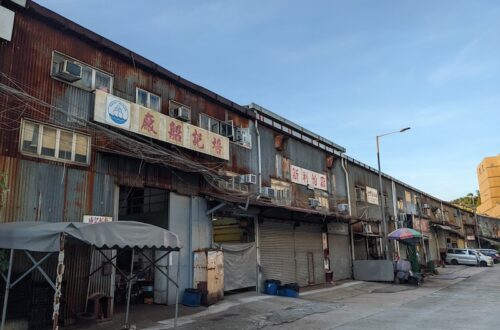
Over the past 70 years, Pui Kee Shipyard has been relocated twice. The seafront has since been transformed into urban sites where Nam On Lane and Aldrich Garden are located. The current Tam Kung Temple Road is where Nam Wah Public Swimming Shed used to stand.
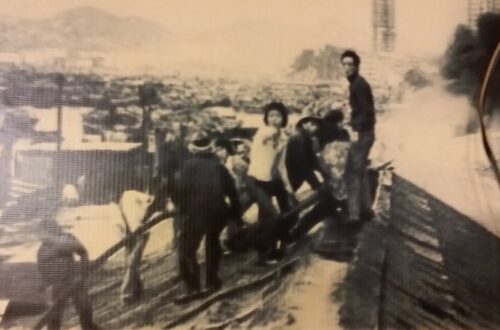
On the second day of the Lunar New Year in 1976, a No 5-alarm fire broke out in the squatter area next to Aldrich Bay. Chuen Gor (in white shirt) followed the fire brigade to fight the fire overnight. This photo is still posted on the wall of a restaurant on Main Street East.
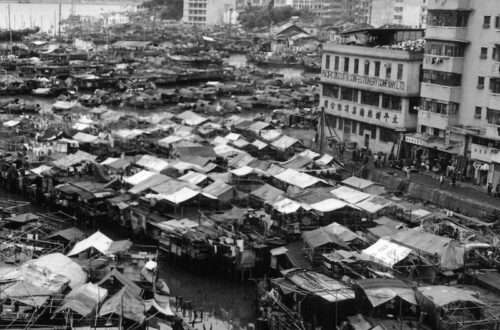
Shau Kei Wan typhoon shelter in 1966. (Provided by Mr Ko Tim Keung)
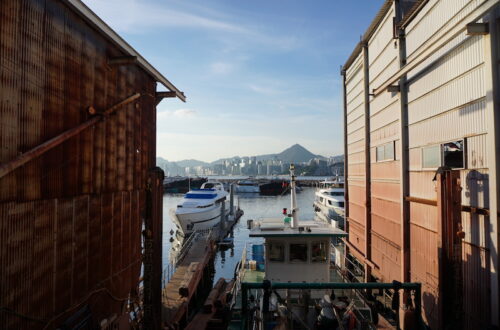
Pui Kee Shipyard has two entrances, with one facing the sea, sending off and receiving countless boats. Chuen Gor said, “A new ship used to cost around $30,000, but now it’s impossible to build one for three million.”
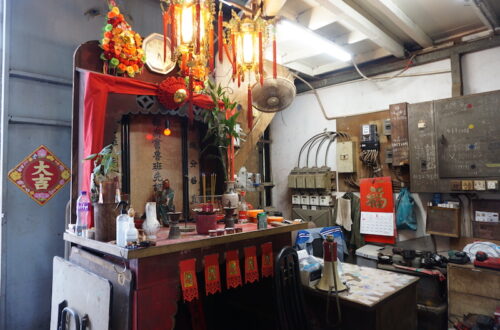
A statue of Lu Ban, the “God of Craftsmen”, stands in the shipyard and a dinner is held to celebrate Lu Ban’s birthday every year.
Connection to Ming Wah Dai Ha: Frequently played ping pong at Ming Wah as a child; many relatives and friends are Ming Wah residents.
細説明華
Ming Wah Dai Ha
Documentary Project
Copyright|Disclaimer | Contact us
Organiser|Hong Kong Housing Society
Collaborator|Dragon Foundation、Lion Head Culture、Hide and Seek Tour
Copyright © 2024 Hong Kong Housing Society. All Rights Reserved.
細説明華
Ming Wah Dai Ha
Documentary Project
Copyright|Disclaimer | Contact us
Organiser|Hong Kong Housing Society
Collaborator|Dragon Foundation、Lion Head Culture、Hide and Seek Tour
Copyright © 2024 Hong Kong Housing Society. All Rights Reserved.